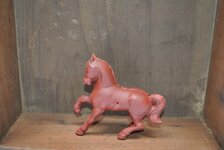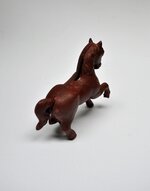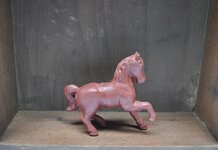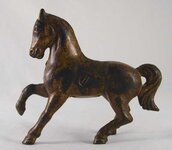Last edited:
Navigation
Install the app
How to install the app on iOS
Follow along with the video below to see how to install our site as a web app on your home screen.
Note: This feature may not be available in some browsers.
More options
You are using an out of date browser. It may not display this or other websites correctly.
You should upgrade or use an alternative browser.
You should upgrade or use an alternative browser.
✅ SOLVED Real or Reproduction!? Brand?!
- Thread starter hnw
- Start date
BosnMate
Gold Member
- Sep 10, 2010
- 6,916
- 8,441
- Detector(s) used
- Whites MXT, Whites DFX, Whites 6000 Di Pro
- Primary Interest:
- Other
Repo, the cross head screw is a dead give away. Those type screw and bolt heads haven't been around all that long, at least not in common use except in the last 50 years of so.
Upvote
0
jewelerguy
Gold Member
I collect still banks and this appears to be (possibly a repro) 'prancing horse' which was made by both the companies of Arcade 1910-1932, and A.C. Williams 1910-1920's. It's possible that it's an original with a recent re-paint which in my personal opinion completely devalues a bank. The screw is the most troubling sign. An original would have a slotted screw head for a straight screw driver. It's possible that someone put a newer screw in an older bank though. The casting of the hole between the tail and the horses rear looks rough enough to be a bad sign too. An original AC Williams or Arcade in original paint would have gold painted hooves as well.
Upvote
0
DCMatt
Gold Member
- Oct 12, 2006
- 10,429
- 13,676
- Detector(s) used
- Minelab Equinox 600, EX II, & Musketeer, White's Classic
- Primary Interest:
- Metal Detecting
Unsolicited, mindless trivia interjection:
So, why do we have "piggy banks"?
For centuries before commercial banking was available, people simply saved their money at home in a box or a jar.
During Tudor era, money was often saved in small , orange clay jars with a slot just large enough to insert coins. This orange clay was known as 'pygg' clay (originally pronounced 'pug').
You can see where this is going... As money jars and the English language evolved, even though the banks were no longer made of the special clay, but the name stuck.
Pygg banks became Piggy Banks over time and were eventually even made in the shape of pigs.
One thing didn't change, though. To get the money out you still needed to destroy the bank. So, if you had a great expense you had to "break the bank" to pay for it.
So, why do we have "piggy banks"?
For centuries before commercial banking was available, people simply saved their money at home in a box or a jar.
During Tudor era, money was often saved in small , orange clay jars with a slot just large enough to insert coins. This orange clay was known as 'pygg' clay (originally pronounced 'pug').
You can see where this is going... As money jars and the English language evolved, even though the banks were no longer made of the special clay, but the name stuck.
Pygg banks became Piggy Banks over time and were eventually even made in the shape of pigs.
One thing didn't change, though. To get the money out you still needed to destroy the bank. So, if you had a great expense you had to "break the bank" to pay for it.
Upvote
0
jewelerguy
Gold Member
Thank you! My thoughts exactly! I am looking to resell it, so does it have any value, despite being a reproduction and having been repainted??
outside of the screw being wrong, it's really hard to tell if it's actually a repro or if it's an original just repainted by someone who didn't know any better. Even with originals there were bad castings and/or clean-up work which left flash or file/grinding marks from it's removal. I'm certainly not an expert by any means. I'm just a guy who likes still banks because of the era they represent when most average people only had coinage and very little paper money. I have a reference book to aid in my own personal collecting. As for me personally, I would not give more than 10 dollars for that bank simply because of the paint job. In my opinion repaint destroys the value and integrity of an antique bank just like that woman did to that antique painting :
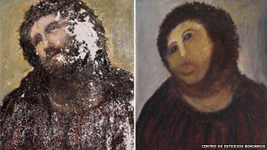
You might be able to realize more than 10 bucks, but only through a flea market or yard sale. Too many available in original paint to try for a better price somewhere online like ebay. Just my opinion. Good luck!
Upvote
0
Users who are viewing this thread
Total: 2 (members: 0, guests: 2)
Latest Discussions
-
-
-
-
-
-
THE Random Chat Thread - AKA "The RCT" - No shirt or shoes required - Open 24 / 7
- Latest: Treasure_Hunter
